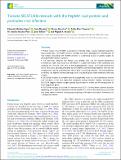Files in this item
Tomato SlGSTU38 interacts with the PepMV coat protein and promotes viral infection
Item metadata
| dc.contributor.author | Méndez-López, Eduardo | |
| dc.contributor.author | Donaire, Livia | |
| dc.contributor.author | Gosálvez, Blanca | |
| dc.contributor.author | Díaz-Vivancos, Pedro | |
| dc.contributor.author | Sánchez-Pina, M. Amelia | |
| dc.contributor.author | Tilsner, Jens | |
| dc.contributor.author | Aranda, Miguel A. | |
| dc.date.accessioned | 2023-02-07T17:30:09Z | |
| dc.date.available | 2023-02-07T17:30:09Z | |
| dc.date.issued | 2023-04-01 | |
| dc.identifier | 282906531 | |
| dc.identifier | cb98eb12-24dd-4994-9cb8-7911983d7426 | |
| dc.identifier | 85147515025 | |
| dc.identifier.citation | Méndez-López , E , Donaire , L , Gosálvez , B , Díaz-Vivancos , P , Sánchez-Pina , M A , Tilsner , J & Aranda , M A 2023 , ' Tomato SlGSTU38 interacts with the PepMV coat protein and promotes viral infection ' , New Phytologist , vol. 238 , no. 1 , pp. 332-348 . https://doi.org/10.1111/nph.18728 | en |
| dc.identifier.issn | 0028-646X | |
| dc.identifier.other | RIS: urn:24FD52730E749FC53F7E3F27623DB240 | |
| dc.identifier.other | ORCID: /0000-0003-3873-0650/work/128568159 | |
| dc.identifier.uri | https://hdl.handle.net/10023/26917 | |
| dc.description | Funding: This work was supported by grants RTI2018-097099-B-I00 and PID2021-125010OB-I00 from Ministerio de Ciencia e Innovación (Spain). EM-L was supported by grant BES-2013-064540 (Ministerio de Ciencia e Innovación; Spain). Work in JT laboratory was supported by the Scottish Government’s Rural and Environment Science and Analytical Services Division (RESAS). | en |
| dc.description.abstract | Pepino mosaic virus (PepMV) is pandemic in tomato crops, causing important economic losses worldwide. No PepMV resistant varieties have been developed yet. Identification of host factors interacting with PepMV proteins is a promising source of genetic targets to develop PepMV resistant varieties. The interaction between the PepMV coat protein (CP) and the tomato glutathione S-transferase SlGSTU38 was identified in a yeast-two hybrid (Y2H) screening and validated by directed Y2H and co-immunoprecipitation assays. SlGSTU38-knocked out Micro-Tom plants (gstu38) generated by the CRISPR/Cas9 technology together with live-cell imaging were used to understand the role of SlGSTU38 during infection. The transcriptomes of healthy and PepMV-infected wild type (WT) and gstu38 plants were profiled by RNA-seq analysis. SlGSTU38 functions as a PepMV-specific susceptibility factor in a cell autonomous manner and re-localizes to the virus replication complexes during infection. Besides, knocking out SlGSTU38 triggers ROS accumulation in leaves and the deregulation of stress-responsive genes. SlGSTU38 may play a dual role: on the one hand, SlGSTU38 may exert a proviral function depending on its specific interaction with the PepMV CP; and on the other hand, SlGSTU38 may delay sensing PepMV infection by participating in the redox intra-cellular homeostasis in a non-specific manner. | |
| dc.format.extent | 17 | |
| dc.format.extent | 4614103 | |
| dc.language.iso | eng | |
| dc.relation.ispartof | New Phytologist | en |
| dc.subject | PepMV | en |
| dc.subject | Potexvirus | en |
| dc.subject | Host factor | en |
| dc.subject | Redox homeostasis | en |
| dc.subject | Resistance | en |
| dc.subject | Stress response | en |
| dc.subject | Viral replication complex | en |
| dc.subject | VRC | en |
| dc.subject | DAS | en |
| dc.subject | MCC | en |
| dc.title | Tomato SlGSTU38 interacts with the PepMV coat protein and promotes viral infection | en |
| dc.type | Journal article | en |
| dc.contributor.institution | University of St Andrews. School of Biology | en |
| dc.contributor.institution | University of St Andrews. Centre for Biophotonics | en |
| dc.contributor.institution | University of St Andrews. Biomedical Sciences Research Complex | en |
| dc.identifier.doi | 10.1111/nph.18728 | |
| dc.description.status | Peer reviewed | en |
This item appears in the following Collection(s)
Items in the St Andrews Research Repository are protected by copyright, with all rights reserved, unless otherwise indicated.

